Estadio Municipal de Anoeta
| Capacity | 40 177 |
|---|---|
| Country | Spain |
| City | San Sebastián |
| Clubs | Real Sociedad de Fútbol |
| Inauguration | 13/08/1993 (Real Sociedad San Sebastian - Real Madrid) |
| Renovations | 2017-2019 |
| Cost | € 55.9 million (2017-2019) |
| Design | Izaskun Larzabal (2017-2019) |
| Contractor | Moyua, Altuna-Uria |
| Address | Paseo de Anoeta 1, E-20014 San Sebastian |
Advertisement
Anoeta – stadium description
Estadio Anoeta was built in the amara district to replace Campo de Fútbol Municipal de Atocha opened in 1913. Exactly 80 years later the new venue was ready for operation. First event ever – Junior European Championships in Athletics on July 29th. Two weeks later came the first football game between Real Sociedad and Real Madrid.
The first club play all their home games from the very opening, though in recent years they've been sharing Anoeta with two French rugby teams, for which it is the most suitable venue. Anoeta is famous for its shape with stands of different height creating very dynamic impression. However, for many years atmosphere within the stadium was criticised, which is not uncommon in cases where fans are as far from the field as 40 meters (fron row behind goals).
They auditorium was covered and massive concrete supports create a very distinctive exterior appearence. In comparison, the roof itself was rather lightweight, formed by 3D steel truss spanning 15,000 m2.
Plans of Anoeta's reconstruction first surfaced in 2004, when the vision of Gipuzkoarena was created, foreseeing a 40,000+ football-only stadium with hotel, shops and offices attached. The plan fell through, as did following attempts to buy the facility from local authorities. Finally, in 2015 a new concept was brought to light, which saw Real Sociedad fund vast majority of the work, leaving remainder to public entities.

Upon commencement of the project in 2017, the budget was estimated to slightly exceed €47 million. Of the amount Real Sociedad would cover €33 million, the Basque Country follow with €10m and the Gipuzkoa province end with €4m. While the main contract stayed within this margin, it didn't include some features (seats, sound system and several other elements, along with stadium perimeter), which means the final price tag exceeds €50 million.
Created by renowned Basque architect Izaskun Larzabal, the concept on one hand leaves as much as possible of the old stadium, while transforming it into a modern football-specific venue. In the end only the upper side sections were left in place, along with their roof, while the remainder is either redeveloped or built from scratch. The challenge became to reconfigure the auditorium, while respecting the old stands' maximum height.
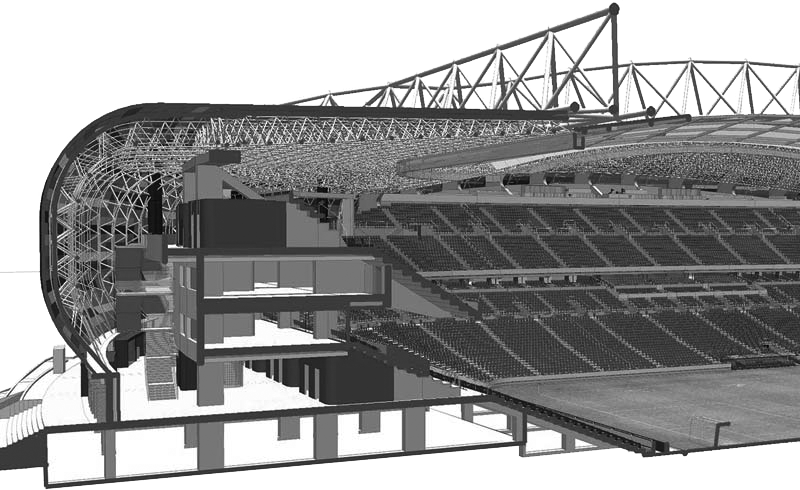
The field was thus lowered by 1.5m, both end stands were built from scratch, replacing demolished curves, while the lower sides were moved towards the field and extended thanks to the space available after field was lowered. The outcome is shortening distance from the field of play from 42 to 8.5 meters behing goals and from 25 to 10.5m on the sides.
At the same time capacity grew significantly, from 32,076 to 39,500. Initial estimates gave capacity at 42,300, but optimisation of hospitality areas and anticipation of some fans standing throughout games in the south end led to reduction. Exceeding 40,000 remains possible in the future with ease, should such need arise.
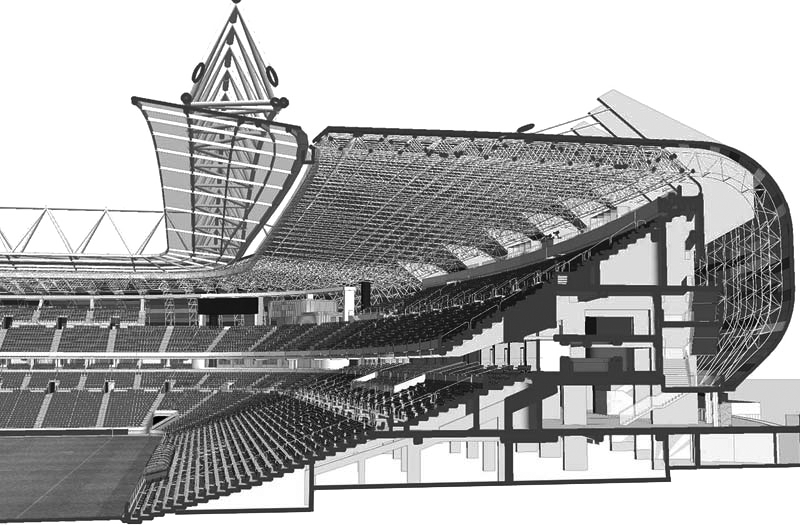
The roof is an interesting structure, utilising the very same system as for the 1993 structure, while also adding four primary trusses on top. The interlocking trusses are 150 long (across the stadium) and 190 meters long (along the stadium) and provide cover for new front rows. Each truss is 10 meters tall and all have been placed atop 25-meter concrete columns, built outside the stadium.
In order to create a uniform appearance of the old and new roofs, the new one also uses a lot of metal sheets for cover, but also incorporates ETFE. Translucent, white membrane covers the inner perimeter of the roof (5,800 m2). ETFE has also been used as new facade material, this time in sky blue (18,500 m2). With 25% translucency it leaves the public concourses well lit during daytime, while also providing cover from rain and wind, not uncommon in San Sebastian.
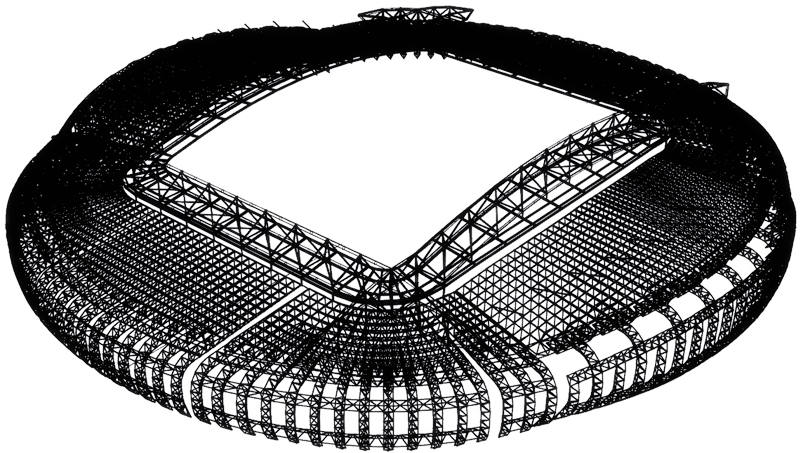
As if the project didn't already have a modest time frame of 2 years, added difficulty was the continued use of the stadium for matchdays. Demolition of the old south end began in May of 2017, while the first game was played in mid-September of 2019, leaving some areas unifnished. The south end was built during 2017/18 and the north one grew even faster, during the 2018/19 season. The busiest period was the summer of 2018, when the field was lowered and both side stands rebuilt. Even two serious accidents on site (worker and roof segment falling down, mobile crane collapsing on the field) didn't impact the schedule in significant manner.
Along with its reopening, Anoeta received the very first naming rights deal. Until 2025 the stadium is named Reale Arena and the insurance provider spent some €6 million on the contract.
How Reale Arena compares to other LaLiga stadiums?
Advertisement
Pictures
-

07.10.2019 © Bhgh543bgf (cc: by-sa) 
04.01.2020 © Bhgh543bgf (cc: by-sa) 
09.09.2019 © Real Sociedad SAD 
09.09.2019 © Real Sociedad SAD 
09.09.2019 © Real Sociedad SAD 
09.09.2019 © Real Sociedad SAD 
09.09.2019 © Real Sociedad SAD 
09.09.2019 © Real Sociedad SAD 
09.09.2019 © Real Sociedad SAD 
09.09.2019 © Real Sociedad SAD 
09.09.2019 © Real Sociedad SAD 
09.09.2019 © Real Sociedad SAD 
09.09.2019 © Real Sociedad SAD 
09.09.2019 © Real Sociedad SAD 
28.02.2020 © Bhgh543bgf (CC BY-SA 4.0) 
28.02.2020 © Bhgh543bgf (CC BY-SA 4.0) 
28.02.2020 © Bhgh543bgf (CC BY-SA 4.0) 
09.09.2019 © Real Sociedad SAD 
09.09.2019 © Real Sociedad SAD 
09.09.2019 © Real Sociedad SAD 
09.09.2019 © Real Sociedad SAD 
10.08.2006 © Borja Iza (cc: by-nc) 
03.08.2013 © Antoon Kuper (cc: by-nc-nd) 
03.08.2013 © Antoon Kuper (cc: by-nc-nd) 
22.12.2016 © Валерий Дед (cc: by-nc-nd) 
22.12.2016 © Валерий Дед (cc: by-nc-nd) 
08.2011 © Leszek Szumski 
08.2011 © Leszek Szumski 
08.2011 © Leszek Szumski 
21.06.2015 © Gure Esku (cc: by-sa) 
22.12.2016 © Валерий Дед (cc: by-nc-nd) 
08.2011 © Leszek Szumski 
06.02.2007 © Alberto Martinez Subtil (cc: by-nc-nd) 
26.08.2008 © Borja Iza (cc: by-nc)
1993-2017:
Related news
2025
-
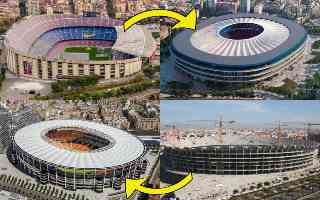
Spain: Dynamically evolving Spanish stadiums
A revolution is taking place in Spanish football stadiums. The latest video on the EstadiosDB channel, available in Spanish, takes viewers on a journey through arenas that have undergone profound transformations in recent years—not always spectacular, but always meaningful. From modest modernisations to major rebuilds, each stadium tells its own story.
-

Spain: Attendance at La Liga stadiums in the 2024/25 season
Attendance at La Liga stadiums this season once again broke all records. Most fans came to the Santiago Bernabéu, but it was Barcelona's temporary stadium that was most full. The stadiums of Espanyol, Las Palmas and Getafe were regularly empty.
-

Spain: We’re launching in Spanish! A new YouTube channel
Some time ago, we quietly launched our new YouTube channel in Spanish – EstadiosDB. In the first full-length video, we present a ranking of the LaLiga 2024/25 stadiums, from Vallecas to Santiago Bernabéu, with an in-depth analysis of each venue.
-
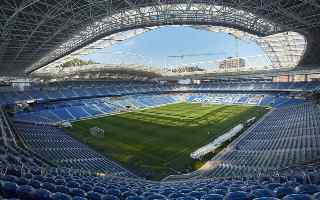
Spain: San Sebastian says “no” to 2030 World Cup?
Although the 2030 FIFA World Cup is still over five years away, opposition is already growing in San Sebastian against the city’s inclusion as one of the host venues. Local neighborhood groups and associations have issued an official letter to FIFA, demanding the city’s withdrawal from the tournament.
-
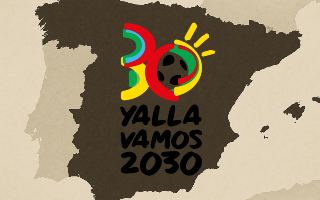
World Cup 2030: Spanish bid, shaken by insecurity, is in FIFA's hands
Shaken by the stadium evaluation affair, the Spanish bid for the 2030 World Cup faces even more challenges in the future. The pressure from Valencia, the problems of Riazor and La Rosaleda and the rising costs cause uncertainty and forecast a fight till the end, which will come with FIFA's decisions.
-

Spain: Guns, a helicopter and suitcases full of money - Spanish mafia at Anoeta
Real Sociedad's stadium is regularly the arena for football clashes and has also sometimes been the scene of rugby duels, but last weekend Anoeta turned into a meeting place for members of the Spanish mafia.
-
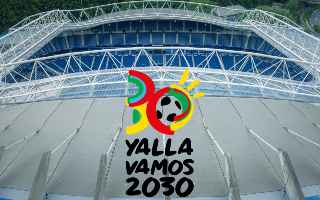
Spain: RFEF closes the “evaluation case” with no changes on World Cup stadium list
Maria Tato has broken her silence. The member of the Spanish World Cup bid, already dismissed from the Spanish federation, denounces that the recordings have been manipulated, and the score of Estadio Anoeta was corrected after an "error". The RFEF has decided not to change the venues and president Rafael Louzán distances himself from the case.
-
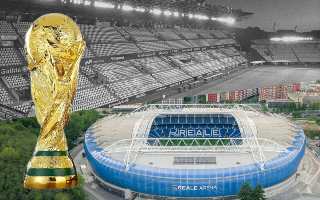
2030 WORLD CUP: RFEF changed scores to have San Sebastian replace Vigo
48 hours. 2 stadiums. 0.4 points. El Mundo’s sources point to strange changes in the evaluation of the candidates to host the 2030 World Cup. After its sudden modification, Vigo dropped from 11th to 12th place, dropping out from the list of hosts.
-
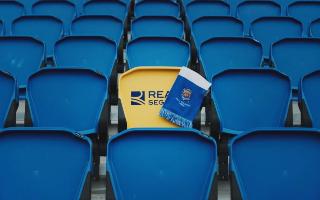
Spain: The end of a unique partnership. Reale Arena changes its name
It is rare for a club to have such a relationship with a sponsor as Real Sociedad had with Reale Seguros. After 13 seasons, the two sides announced the end of their partnership, exchanging meaningful gestures. The company released a touching video and the club, as a gesture of appreciation... created a special chair in the stands dedicated to the sponsor.
-
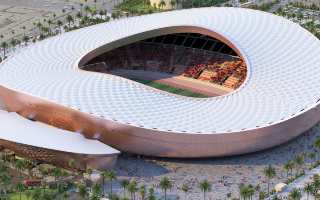
WC 2030: FIFA looks to reduce number of venues for 2030 World Cup
A tournament on two continents may not be without difficult decisions. The number of host stadiums will be reduced from the original 20 to as few as 17 venues, according to Spanish media speculation. According to reports, this reduction could affect both Morocco and Spain.
2024
-
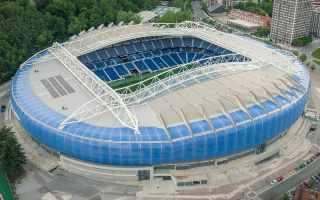
Spain: Real Sociedad decides to increase Anoeta's capacity
More capacity and more investment. Real Sociedad is planning an expansion of the Reale Arena in response to the demand for season tickets and to meet FIFA's requirements for the 2030 World Cup.
-

FIFA: World Cup 2030 stadium evaluation. Camp Nou in the lead
Of the 23 stadiums to host the 2030 World Cup matches, as many as 14 either exist only on paper or will undergo deep redevelopment before the tournament. Nevertheless, FIFA has evaluated each of them before the Extraordinary Congress, which will already make its final decision on December 11. Also the one about the final arena.
-

Spain: Spanish football unites to help Valencia after tragic floods
Although many players and coaches asked to suspend all the matches of the last week due to the tragedy caused by the “cold drop” weather phenomenon, La Liga authorities decided to cancel only the matches in the affected areas. Even so, the stadiums ceased to be just temples of football to become examples of solidarity with the survivors.
-

Spain: Real Sociedad fan dies while entering Reale Arena
A fall caused the death of a socio in San Sebastian just before the start of the match against Real Madrid. The club has announced its condolences to the family and friends of the deceased, while Ertzaintza, the local police, has opened an investigation to discover the cause of the tragedy.
-

World Cup 2030: Spain selected 11 stadiums. Which ones are missing?
By July 31, Spain will present to FIFA the stadiums that, along with venues in Morocco and Portugal, will be part of the 2030 World Cup. The idea of proposing as many as 13 arenas was rejected, and ultimately, only eleven will be presented.
-

Spain: The Champions... Burger? Unusual competition at Reale Arena
Six months after Real Sociedad's Champions League appearance, Reale Arena is hosting another event with ‘Champions’ in the name. From July 11 to 21, the Reale Arena is transformed into the world's biggest burger restaurant. The event aims to determine the best restaurant serving burgers in Spain.
-

World Cup 2030: The race for the final (and more) enters decisive phase
Recent weeks have been tumultuous for the candidate cities, but the next few weeks will be a real storm. Of the 14 Spanish arenas aspiring to host the World Cup, only 11 will be chosen. Bernabéu, Camp Nou and Grand Stade de Casablanca are vying to host the finals, although the Moroccan megastadion exists only on paper for now.
-
Spain: Attendance at La Liga stadiums in the 2023/24 season
More than 11 million tickets were sold for Primera División matches. The record number represents another increase on previous seasons. Real Madrid and Atletico surpassed the one million spectator barrier, while Barcelona surprised by recording a mere 80% stadium fill despite playing at Montjuic. Two clubs, on the other hand, did not even exceed 70%.
2023
-

Spain: Reale Arena pushes for 2030 World Cup
Among the Spanish venues aspiring to become hosts of the World Cup held on 3 continents, things are starting to get crowded. Each candidate is trying to improve its position on the final straight, and San Sebastián doesn't want to be left behind.
-

World Cup 2030: The list of venues that will host the tournament is clarifying
2030 FIFA World Cup will enter a higher level. After the event was played four years earlier on the territory of three different countries, the world football authorities have decided to organize the competition on three separate continents. Which venues will be on the list of host cities?
 StadiumDB
StadiumDB